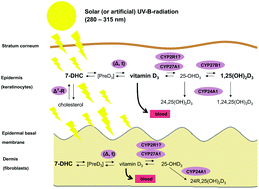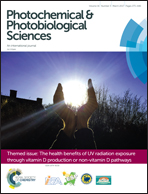Challenge and perspective: the relevance of ultraviolet (UV) radiation and the vitamin D endocrine system (VDES) for psoriasis and other inflammatory skin diseases
Abstract
During evolution, the ability of many organisms to synthesize vitamin D photochemically represented, and still represents, a major driving factor for the development of life on earth. In humans because not more than 10–20% of the requirement of vitamin D can be satisfied by the diet (under most living conditions in the US and Europe), the remaining 80–90% need to be photochemically synthesized in the skin through the action of solar or artificial ultraviolet-B (UV-B) radiation. The skin is a key organ of the human body's vitamin D endocrine system (VDES), representing both the site of vitamin D synthesis and a target tissue for biologically active vitamin D metabolites. Human keratinocytes contain the enzymatic machinery (CYP27B1) for the synthesis of the biologically most active natural vitamin D metabolite 1,25-dihydroxyvitamin D3 (1,25(OH)2D3), representing an autonomous vitamin D3 pathway. Cutaneous production of 1,25(OH)2D3 may mediate intracrine, autocrine and paracrine effects on keratinocytes and on neighboring cells. Many skin cells (including keratinocytes, sebocytes, fibroblasts, melanocytes, macrophages and other skin immune cells) express the vitamin D receptor (VDR), an absolute pre-requisite for exerting genomic effects of 1,25(OH)2D3 and analogs. The VDR is a member of the superfamily of trans-acting transcriptional regulatory factors, which also contains the steroid and thyroid hormone receptors as well as the retinoid-X receptors (RXR) and retinoic acid receptors (RAR). A large body of evidence, including cDNA microarray analyses of mRNAs, indicates that as many as 500–1000 genes may be controlled by VDR ligands that regulate a broad variety of cellular functions including growth, differentiation, and apoptosis. Clinical and laboratory investigations, including the observation that 1,25(OH)2D3 is very effective in inducing the terminal differentiation and in inhibiting the proliferation of cultured human keratinocytes have resulted in the use of 1,25(OH)2D3 and analogs for the treatment of psoriasis. Focussing on the UV-induced cutaneous synthesis of vitamin D, this review gives an update on the relevance of the VDES and of UV radiation for the management of psoriasis and other inflammatory skin diseases.

- This article is part of the themed collections: 2017 Perspective articles collection and The health benefits of UV radiation exposure through vitamin D production or non-vitamin D pathways

 Please wait while we load your content...
Please wait while we load your content...